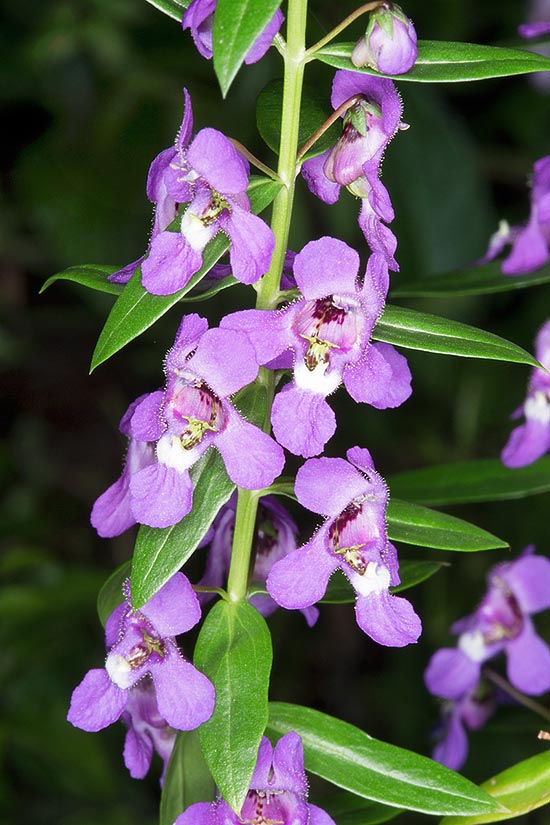Family : Plantaginaceae

Text © Pietro Puccio

English translation by Mario Beltramini

Native to the semi-arid zones of Brazil and Venezuela, Angelonia salicariifolia is a 30-80 cm perennial herbaceous species. Long blooming in the tropical gardens and medicinal virtues © Giuseppe Mazza
The name of the genus comes from the local one “angelon” used in Venezuela; the specific name is the combination of the Latin adjective “salicarius, a, um” = similar to the willow, and of the substantive “folium, ii” = leaf, with obvious reference.
Common names: angelonia, angel mist, grannie’s bonnets, monkey face, purple angelonia, summer snapdragon, willowleaf angelon (English); angelon (Venezuela).
The Angelonia salicariifolia Humb. & Bonpl. (1812) is a usually erect perennial herbaceous species, 30-80 cm tall, with pubescent quadrangular stems, simple or ramified at the base, and opposite sessile leaves, decussate, simple, oblong with pointed apex and slightly toothed margins, 3-10 cm long and 0,5-1,8 cm broad, of decreasing dimensions towards the apex, covered by tiny glandular hairs on both faces, aromatic. Solitary flowers at the axil of the terminal leaves, on an about 1,5 cm long peduncle, 1,4-2 cm broad, with green calyx with 5 lobes, about 0,4 cm long, ovate-lanceolate with pointed apex and provided of glandular hairs. Almost bilabiate corolla, of more or less violet colour, with concave throat, biparted upper labrum and triparted lower one with the intermediate part longer, and rounded margins, 4 stamina and pubescent spherical ovary. The fruit is a bilocular globose capsule containing numerous seeds.
It propagates by seed, in draining loam maintained humid at the temperature of 24-26 °C, but usually by cutting and semi-woody stem portions horizontally arranged.
Very ornamental species with long lasting blooming, amply diffused, along with its numerous varieties, in the gardens of the tropical and subtropical countries, often naturalizing, for flower beds, borders and masses of colour; cultivable also as annual in the colder climates. It requires an exposition in full sun and draining soils acidic to neutral; well rooted can stand periods of dryness, but grows better if regularly irrigated in the warmest months. The prunings foster the formation of new vegetation and the blooming. It well adapts to the cultivation in pot, utilizing a draining loam rich of organic substance, for the decoration of patios, balconies and terraces with regular waterings and fertilizations, during the vegetative period, with balanced product, with microelements, specific for the flower plants in pot. The cut flowered stems, long lasting, are used in the floral compositions. The plant is utilized locally in the traditional medicine.
→ To appreciate the biodiversity within the PLANTAGINACEAE family please click here.
